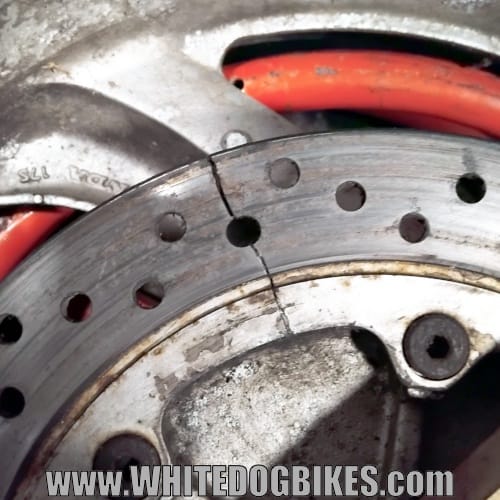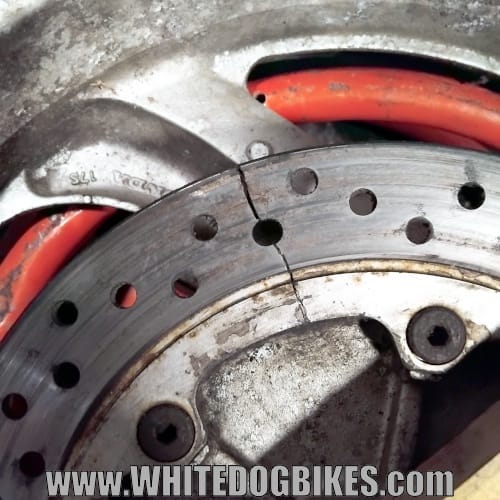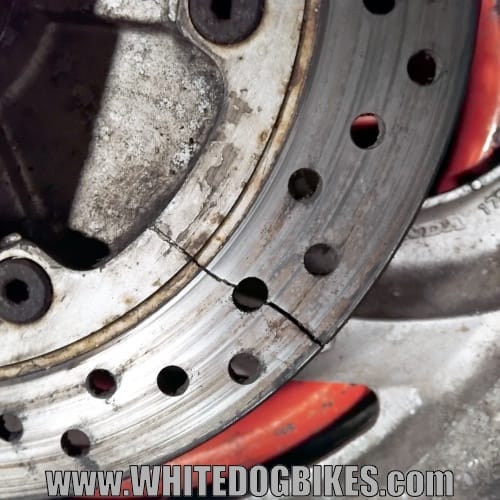Quick, visual motorbike checks are often overlooked before going out, wether it’s for a weekend blast or regular commute, but there’s a very good reason to do a visual check.
Note – Visual checks can be done on many parts of the motorcycle, this post only looks at the rear brake due to a problem found on a bike we had.

Damaged rear brake disc found on a Honda Deauville rear wheel
Brakes are one of THE MOST IMPORTANT safety features of any motorcycle, a quick visual check can help to spot any problems with the braking system and potentially avoid the brakes from failing when there needed.

Crack through the entire disc.
Visually checking your motorcycle brake discs before every ride is crucial for your safety and the overall performance of your bike.
Here’s why it’s so important and what to look for:
Why It’s Important…
- Safety First: Your brakes are arguably the most critical safety system on your motorcycle. Any issue with them can severely compromise your ability to stop, leading to accidents and serious injury.
A quick visual check can identify potential problems before they escalate into dangerous failures. - Preventing Further Damage: Addressing minor issues early can prevent them from becoming major, costly repairs. For example, replacing worn pads before they damage the discs can save you a significant amount of money and hassle.
- Optimal Braking Performance: Healthy brake discs, in conjunction with good pads and fluid, ensure consistent and effective braking. Worn or damaged discs can lead to reduced stopping power, vibrations, and unpredictable braking.
- Roadworthiness: In the UK a cracked brake disc would be an MOT failure for a motorcycle (as well as other things like excessively worn pads etc).
What to Look For During a Visual Inspection…
When you visually check your brake discs, pay attention to the following:
- Disc Surface Condition:
Scoring/Grooves: Look for deep scratches or grooves on the disc surface. Minor scoring is normal, but deep grooves indicate excessive wear, often caused by worn-out brake pads (metal-on-metal contact) or debris caught between the pad and disc. Deep scoring significantly reduces braking effectiveness as it reduces the surface area of the brake pad that is in contact with the disc.Glazing: The disc surface should not have a shiny, glass-like appearance. Glazing can occur due to excessive heat or improper bedding in of new pads, reducing friction and braking power.
Hot Spots/Blueing: Look for discolored areas (blue or rainbow tints) on the disc. These are “hot spots” caused by extreme heat, which can indicate warping or uneven contact and can lead to reduced braking performance and vibration.
Contamination: Check for any signs of grease, oil, brake fluid leaks, or other contaminants on the disc surface. These can drastically reduce friction and stopping power.
- Warping/Deformation: While difficult to confirm without specialized tools (like a dial indicator), you can often get a sense of warping by visually inspecting the disc from different angles or by spinning the wheel slowly and observing if the disc wobbles. A warped disc will cause pulsing through the brake lever and compromised braking.
Note – Although you would need to be careful incase the warping has severly reduced braking effectiveness, a short ride can help to check as you should feel a juddering on the front end when braking if the disc(s) are warped.
- Cracks: Inspect the entire disc for any signs of cracks, especially around the mounting points or the ventilation holes. Cracks are a serious safety concern and require immediate replacement.
- Minimum Thickness: Most brake discs have a minimum thickness stamped on them (often “Min.Th.” followed by a measurement).
While you can’t accurately measure this with a visual check, if you notice a significant “lip” on the outer or inner edge of the disc where the pads don’t contact, it’s a strong indicator that the disc is nearing or has passed its minimum thickness and needs to be replaced.Note – Brake discs become more prone to cracks the thinner they get
- Cleanliness: Ensure the discs are free from excessive brake dust buildup, especially in any ventilation holes. While not always a direct sign of damage, a clean disc allows for better heat dissipation and more effective braking.
Note – Use brake cleaner to help remove brake dust build up
Important Note: If you identify any significant issues during your visual inspection, or if you experience any strange noises, vibrations, or reduced braking performance while riding, it’s essential to have your brake system professionally inspected and serviced by a qualified mechanic.
Do not ride the motorcycle until the issue is resolved.

A crack like this is an MOT failure in the UK and could lead to the brake pads jamming and locking the back wheel up!
Disclaimers:
The information provided on this page is ‘to the best of our knowledge’ and should not be taken as 100% accurate!!
To keep this page as a free resource for people to use, there are affiliate links (mainly Amazon) throughout the article. These affiliate links help maintain the cost of running this blog (basically, if you visit Amazon through one of the links and buy something, we make a few pence!).

Leave a Reply